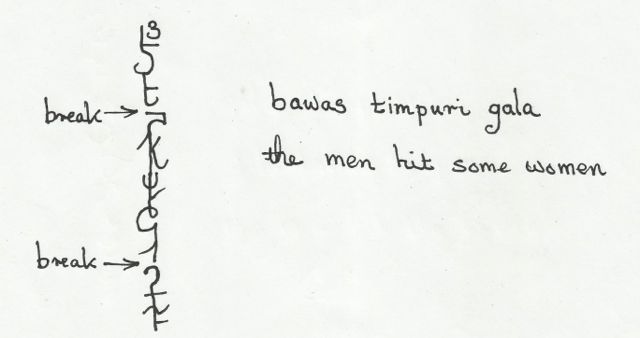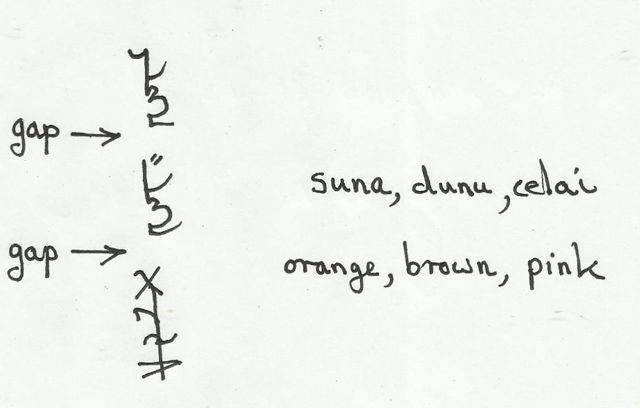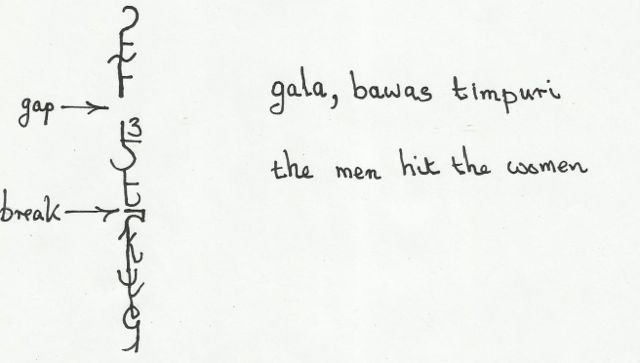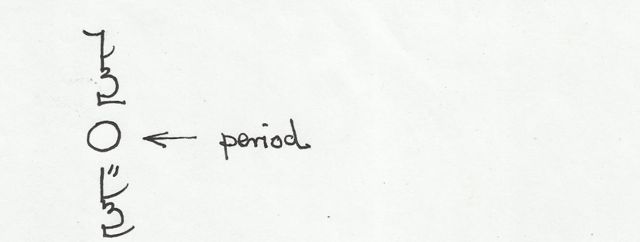Béu : Chapter 5
..... Punctuation and page layout
..
The letters in a word are always contiguous, that is there is always a line running right through the word. Writing is firstly from top to bottom and secondly from left to right.
Between words there is a small break in the line. See the figure below ...
..
..
When you have items listed, béu is exactly the same as English : there is a pause between every item. A pause is represented by a gap in the writing system. See the figure below ...
..
..
By the way, the last two items on the list don't have a pause but are separated by wí "and".
..
It is also a requirement of béu grammar that any NP's that are adjacent to each other, have a pause between them. Hence ...
..
..
The gaps in the writing system reflect exactly where pauses occur. So in a passage, where it would be appropriate for a speaker to take a breath, you will find a corresponding "gap".
Single gaps are very common. Occasionally you can have "double gaps" and even "treble gaps". These rare creatures represent "pregnant pauses" which are sometimes used for comic effect.
..
..
There is also a punctuation mark called the "sunmark". This is basically a full-stop.
..
In a normal narrative, everything is written in "textblocks". See figure below ...
..
..
Textblocks fit in between "rails" about 4 inches apart. The width of a block should be between 60% and 90% * of the block height. Of course it is best to start a new block when the scene of the narrative changes or there is some discontinuity of the action, but this is not always possible.
There is no way to split a word between two lines (as we can do in the West by using two hyphens). If a line (or should I say column) ends in a "sunmark", the next column will begin with a sunmark.
The first text block starts at the top left (as you would expect). The second textblock starts below where the first text block stops. In fact the vertical space between the stop and the start of the two textblocks is equal to the horizontal "interblockspace" (see the figure above).
When you come to the end of the page (you will have some sort of margin of course and not go all the way to the edge), you simply continue the block on the LHS of the next rail (or page).
There are two sizes for books. For all hardback books the size is about 8 inches by about 11 inches. For all paperback books the size is about 5 inches by about 8 inches. They are stored as shown in the figure below.
..
..
Unlike books produced in the West, these books are held with the spine horizontal when being read. The hardback page has two "rails" per page (i.e. three dark lines).
On the paperback book, the title is written on the spine and on the front of the book. On the hardback book the title is written on the front, also there is a flap that slides into the spine. However when the book is stored on a shelf, it is pulled out and hangs down. Hence the hardback books can be easily located, even when they are in the bookshelf.
In every textblock, one word is highlighted. It is usually a noun and the more iconic the better (for example Elephant or Mouse are highly iconic). This word is highlighted in a red colour. Sometimes an active verb is highlighted. These are highlighted in a green colour. Sometimes an adjective is highlighted ... orange colour. Sometimes an infinitive is highlighted ... pink colour
A book will be divided into chapters. A chapter will have a number and usually a title as well. Either at the end of the book or just after the chapter, there will be a page, in which all the highlighted words for a chapter are listed in order. Instead of referencing things by page number, things are reference by chapter and textblock (indictated by the highlighted word(s) ).
Any particular word in a book can be reference by 5 parameters ...
1) "title of book"
2) "title of chapter" (or "number of chapter")
3) the textblocks position (i.e. textblock number 5) plus the highlighted word(s)
4) the number of the sunmark (the number zero is used if the word being referenced is before the first sunmark
5) the number of the word
Also when direct dialogue is quoted ... the words of the first protagonist is highlighted in yellow ... those of the second in blue ??
* Occasionally very narrow blocks can not be avoided. And of course in mathematical/scientific tracts the tracts are all over the place ... interspersed with diagrams and what have you.
..... How to bring a word into focus
Actually there is a way to focused elements in a statement which mirrors the way to focus elements in a question. We use cà for this.
Statement 1) báus glaye timpi alhai = the man gave flowers to the woman
Focused statement 2) báus glaye cà timpi alhai = It is the woman to whom the man gave the flowers.
Any argument or in fact the verb itself can be focused in this way.
..... How to ask a polar question
..
A polar question is a question that can be answered with "yes" or "no".
To turn a normal statement into a polar question (i.e. a question that requires a YES/NO answer), we stick the particle ʔái on the end of the sentence.
ʔái is neutral as to the response you are expecting.
To answer a positive question, YES or NO ( ʔaiwa àu aiya ) is sufficient.
To answer a negative question positively, YES ( ʔaiwa ) is enough.
To answer a negative question negatively, you must give an entire clause.
For example ;-
Question 1) glà (rà) haube ʔái = Is the woman beautiful ? .......... If she is beautiful, answer ʔaiwa, if she isn't answer aiya.
Question 2) glà ká haube ʔái = Isn't the woman beautiful ? ........ If she isn't beautiful, answer ʔaiwa, if she is answer ò rà hauʔe. (notice that the copula must be used in this case)
The above method questions the entire clause. However if you want to question one element in a clause, put ʔái immediately after it.
Statement 1) báus glaye dori alhai = the man gave flowers to the woman
Straight question 2) báus glaye dori alha ʔái = did the man gave flowers to the woman ?
Focused question 3) báus glaye ʔái dori alha = Is it the woman that the man gave flowers to ?
Focused question 4) báus ʔái glaye dori alha = Is it the man that gave flowers to the woman ?
Focused question 5) alha ʔái báus glaye dori = Is it flowers that the man gave to the woman ? ... Well alha ʔái can be anywhere to the left of the verb for this meaning.
Focused question 6) báus glaye dori ʔái alha = the man GAVE flowers to the woman ? (a possible situation ... the speaker has previously thought the woman had stolen the flowers)
..
..... How to ask a content question
..
English is quite typical of languages in general and has 7 content question words ... "which", "what", "who", "where", "when", "how" and "why".
A corresponding set of béu question words are given below.
..
| Question word | Noun/pronoun | Head for HRC ?? | |||
| nén nós | what | ||||
| mín mís món | who | ||||
| kói | when | kòi | occasion, time | koi.a | "the time that", when |
| déu | where | dèu | place | deu.a | the place that |
| kái | "what kind of" | kài | sort, type | kai.a | "the type that", "as" |
| láu | "how much" or "how many" | làu | amount | lau.a | the amount that |
| nái | which | ||||
| fáu | how |
..
*What about the ergative case ??
nenji = why, but as it is derived from nen in a regular way, it is not mentioned in the above table.
The head of headless relative clauses about things ... ʃì à or só ʃì à.
The head of headless relative clauses about people ... ò à or só ò à ... nù à or só nù à ... well actually any pronoun can be patterned like this.
In English as in about 1/3 of the languages of the world it is necessary to front the content question word.
In béu these words are usually also fronted. They must come before the verb anyway. If they come after the verb, they mean "somebody/something", "somewhere" etc. etc.
The pilana are added to the content question words as they would be to a normal noun phrase.
Here are some examples of content questions ...
Statement 1) báus glaye dori alha = the man gave flowers to the woman
Question 2) mís glaye dori alha = who gave flowers to the woman
Question 3) báus minye dori alha = to whom did the man gave flowers
Question 4) báus glaye nén dori = what did the man give to the woman
Question 5) báus yè glà nái dori alha = to which woman did the man give the flowers = báus dori ye glà nái alha
Statement 1) báus glaye dori alha = the man gave flowers to the woman .................known to speaker .......... known to addressee
Statement 2) báus dori yè glà alha = the man gave flowers to a woman .............................? ......................... unknown to addressee
Statement 3) báus dori yè é glà alha = the man gave flowers to some woman ..........unknown to speaker..... unknown to addressee
Statement 4) báus dori yè glà fana alha = the man gave flowers to a certain woman ... known to speaker ........ unknown to addressee
If NP before verb => known to addressee
If NP after verb => unknown to addressee
If NP has é (before the head) => unknown to speaker ... sort of
If NP has fana (after the head) => known to speaker ... fana = known ... fàu = to know
..
..... How A O and S arguments are identified
In this section we discuss pronouns and also introduce the S, A and O arguments.
béu is what is called an ergative language. About a quarter of the world languages are ergative or partly ergative. So let us explain what ergative means. Well in English we have 2 forms of the first person singular pronoun ... namely "I" and "me". Also we have 2 forms of the third person singular male pronoun ... namely "he" and "him". These two forms help determine who does what to whom. For example "I hit him" and "He hit me" have obviously different meanings.
..
In English there is a fixed word order, which also helps to tell who did what to who when the participants are given as nouns instead of pronouns. In béu the order of the verb and the participants are not fixed as in English.
..
glàs baú timpori = The woman hit the man
glà baús timpori = The man hit the woman
It can be seen that "s" is added to the "doer" of the action.
..
However consider the clause below ...
..
glà doikor = The woman walks
It can be seen that the "doer" does not have an attached "s" in this case.
The reason is that "to walk" is an intransitive verb while "to hit" is a transitive verb
It is the convention to call the doer in a intransitive clause the S argument.
It is the convention to call the "doer" in a transitive clause the A argument and the "done to" the O argument.
A language that has the S and O arguments marked in the same way is called an ergative language
If you like you can say ;-
In English "him" is the "done to"(O argument) : "he" is the "doer"(S argument) and the "doer to"(A argument).
In béu ò is the "done to"(O argument) and the "doer"(S argument) : ós is the "doer to"(A argument).
..
..... Transitivity and the useful word "á"
..
In béu a verb is either transitive or intransitive. There is no "ambitransitive verbs as in English.*
For example ... in English, you can say ... "I will drink water" or simply "I will drink"
The second option is not allowed in béu ... as "drink" is a transitive verb, you must say "I will drink something" = solbaru á
Well actually you can, the á can be dropped ... just as easily as the pás is dropped. The point is that the listener "knows" that there are always 2 arguments. The same can not be said in English when you here "he drinks" ... it could mean that the subject habitually drinks alcohol, in which case we have only one S argument.
For another example ... in English, you can say ... "the woman closed the door" or simple "the door closed".
The second option is not allowed in béu ... as "close" is a transitive verb, you must say "something closed the door" = pintu nagori ás
(Actually there is another option for expressing the above ... you can change any transitive verb to an intransitive verb ... pintu nagwori = "the door was closed"
..
If an argument is definite in béu it is usually comes before the verb, and if indefinite it usually comes after the verb.
Now the word é is by definition indefinite. It actually means "somebody" OR "something". What happens if this word is put before the verb.
Well something quite interesting happens ... é changes into a question word meaning "who" or "what"
For example ... és pintu nagori = Who/what closed the door
For another example ... "what will I drink" = é solbaru
And yet another one ... "who drank the water" = és moze solbori
..
*Actually you can tell the transitivity of a verb (for a word of more than one syllable) by looking at its last consonant. If the last consonant is j b g d c s k or t then it is transitive. If it is ʔ m y l p w n or h it is intransitive.
There is about 300 words that have an intransitive form as well as a transitive form, only differing in their final consonant. The relationship between these final consonants is shown below. x means "any vowel".
| transitive | intransitive |
| -jx | -lx |
| -bx | -ʔx |
| -gx | -mx |
| -dx | -yx |
| -cx | -wx |
| -sx | -nx |
| -kx | -hx |
| -tx | -lx |
..
NB ... y and w are usually not allowed to be the second element in a word ... but in these special words, they are.
..
..... Correlatives
..
| ibu | anybody, any one | ivanyo | anything |
| ebu | somebody, some one | evanyo | something |
| ebua | some people | evanyoi | somethings |
| ubu | everybody (collective) | uvanyo | everything (collective) |
| yubu | everybody (individual) | yuvanyo | everything (collective) |
| jubu | nobody, no one | juvanyo | nothing |
| .... | .... | .... | .... |
| iko | anytime | ide | anywhere |
| eko | once | ede | somewhere |
| ekoi | some times | edeu | some places |
| uko | always | ude | everywhere (collective) |
| yuko | everytime | yude | everywhere (collective) |
| juko | never | jude | nowhere |
| .... | .... | .... | .... |
(SideNote) ...
-bu does not occur as an independent word but does occur as a suffix ... beubu = a person who follows the precepts of béu
fanyo is an independent word, meaning "object", "physical thing"
-ko is not an independent word or a suffix. However kòi is a word meaning "occasion", "time".
-de is not an independent word. However dèuì is a word meaning "place".
(SideNote) ...
kói = when
déu = where
koi.a = the time that, when
deu.a = the place that, where
koigan = time
deugan = space
..... More about the pilana
-la or là
mat (rà) floorla => the mat is on the floor ... notice "the mat"
twor mat floorla => there is a mat on the floor ... notice "a mat". Also the verb two is usually sentence initial, at least when introducing something new.
meu (rà) topla nambon => The cat is on top of the house
Notice that "topla nambon" is allowed, I should mention this somewhere.
twor ble pàn = I have (some) money
ble twor pàn = I have the money
tworka ble pàn = I don't have any money .... Note that it is also possible to say twor yà ble pàn, but the first method is definitely preferred.
ble tworka pàn = I don't have the money
bird (rà) top nambon = The bird is above the house
Notice that in the above example "top" is considered a specifier ... "top nambo" forms a tight compound.
The eight specifiers of location are above, below, right, left, this side (with respect to the speaker, of course), the far side
yè and fí are not used for locations. Instead the transitive verbs "arrive" and "leave" are used in a SVC.
Also the words "come" and "go" covered by "arrive" and "leave".
When not talking about location, yè and fí are used.
For example ...
She gave food to the beggar = ...... beggarye
The beggar got food from the woman = ...... wamanfi
Verbs such as hear and tell use these pilana also.
Also such sentences as ...
I was made to sing by the guard = I receive sing guardfi
He made the prisoner sing = He give sing prisonerye
Also such sentences as ...
He went from being very rich, to very poor, within six months
use yè and fí
..... Index
- Introduction to Béu
- Béu : Chapter 1 : The Sounds
- Béu : Chapter 2 : The Noun
- Béu : Chapter 3 : The Verb
- Béu : Chapter 4 : Adjective
- Béu : Chapter 5 : Questions
- Béu : Chapter 6 : Derivations
- Béu : Chapter 7 : Way of Life 1
- Béu : Chapter 8 : Way of life 2
- Béu : Chapter 9 : Word Building
- Béu : Chapter 10 : Gerund Phrase
- Béu : Discarded Stuff
- A statistical explanation for the counter-factual/past-tense conflation in conditional sentences






